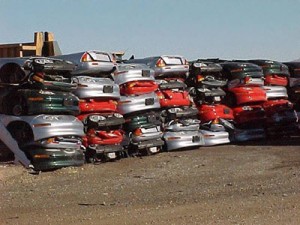
Al Gore fanatics and “combustion engine luddites” have been screaming for years about hybrids and their benefit to the environment and urban life. Evidence to the contrary has never done anything to diminish the hysteria. First one can point out that Hummers turn out to be more environmentally friendly than the Prius ( according to the Green Party of Canada). Secondly, you have “the Prius effect“, which means that basically the incentive for light rail becomes obsolete the more widespread hybrids become. And now, evidence is clear that building and buying hybrids is feeding war profiteers in central Africa as the race to corner rare earth metals accelerates.
Just what are Rare Earth Metals? They include indium, gallium, lanthanum, yttrium, europium and neodymium. These metals are found only in a few places on Earth, and the US relies on imports for 100% of its supply. This is not because rare earth metals aren’t in North America. They are. It’s because Rare Earth mining is not pretty. A mine in California’s Mohave desert, first opened in the early 1950s, is about one-quarter of a mile wide, and over 500 feet deep. So, environmentalists have shifted the burden of finding these rare metals to other parts of the world.
China recently has recently announced it is proposing a total ban on exports of terbium, dysprosium, yttrium, thulium, and lutetium. Other metals such as neodymium, europium, cerium, and lanthanum would be restricted to a total of 35,000 tonnes a year, which is far below global needs. Neodymium is the key component in high-power lightweight magnets for electric motors in hybrid cars, needing over 2lbs for every car. Each hybrid battery uses 22-33lbs of Lanthanum. And there aren’t any alternatives for these elements. Neodymium and Lanthanum are both mined cheaply in the Congo. Want to talk about the myth of peak oil? Start talking about the reality of peak rare metals instead, you’ll be more credible.
Tantalum is the latest “gold rush” metal. Tantalum is used in capacitors which store and release electric charges, such as the ones used to power hybrid motors. As environmental pressures on Australian mining pushes tantalum prices higher, mines in Congo are rushing to fill the void. The tantalum in the DRC is far more inexpensively produced compared to mining operations in the Western world. And some of it can be extracted dirt cheap because of the brutal enslavement of civilian workforces — including young children — by armed factions. Located in war-torn eastern Congo, these primitive open pit quarries are controlled by various militias, rebel groups and renegade elements of the Congolese army. These lawless thugs have profited for the past few years from the tantalum, which is known as “coltan” in Africa, by terrorizing rural communities and forcing locals to dig for this rare mineral by hand. By the way, if you own a mobile phone or a laptop or any other portable electronic device, then there is a good likelihood that one or more of your devices contains “blood tantalum.” And the odds are about to increase that more of this illicit tantalum will find its way into your hands.
Did you know that over three pounds of Cobalt are used in every hybrid car? Care to guess where Cobalt principally comes from? That’s right. The Congo.
The six-year civil and international war in Congo that has killed more than four million people and displaced another two million may have ‘officially’ ended, but the dying has certainly not. Every day in Congo, a deadly combination of conflict-related atrocities (in which rape is widely used as a weapon by all parties involved), starvation, poverty and disease kills over 1,200 people. This conflict is for sure one of the most under-reported human tragedies of our lifetime, yet it is one of the most lethal since World War II. Decades of unrelenting violence, poverty, and disease have created what the United Nations has called the greatest humanitarian challenge now facing the world. Also it seems that the global peace movement has greatly neglected this bloody, but also very complex war, in which so many groups, countries and war profiteers are involved.
So, its time to dump your hybrids and your laptops and your cell phones. No blood for hybrids!
Or do you prefer to accept reality and realize that your need to purchase materials to satisfy your standard of living is not the cause of violence and bloodshed, but the lack of morals and cultural priorities of those you buy it from is? Or perhaps you will be willing to accept a moral alternative and mine in our own backyard?
God forbid.
Two other questions need to be answered. As the Priuses and their mousy counterparts have been on the market for a few years now, one never hears anything about the recycling or disposal or exchange of their batteries (which I recall are worth less than 100k miles of service).
These things have to be expensive, environmentally impactful and difficult to handle when replaced, so what’s then the additive costs and how does that figure into the overall savings that touted for their fuel economy? The environmental wackos never seem to bring this us.
OC Weekly ran a story some time ago explaining the real costs of building these things, and its not a business plan that’s going to win any awards.
Good post.